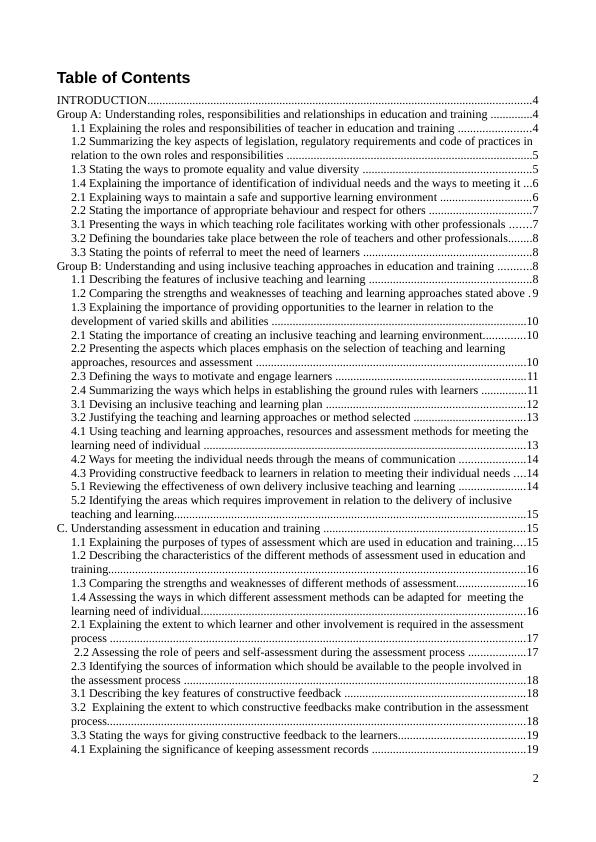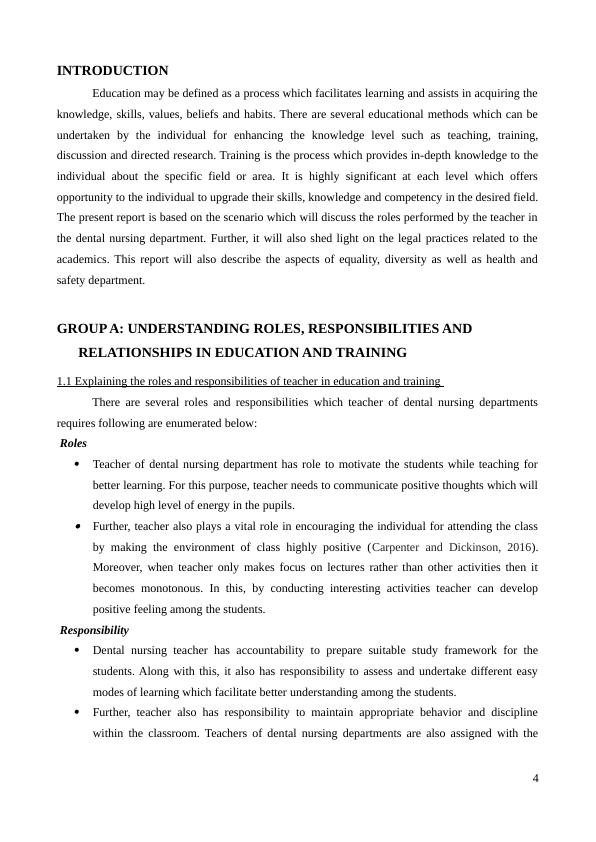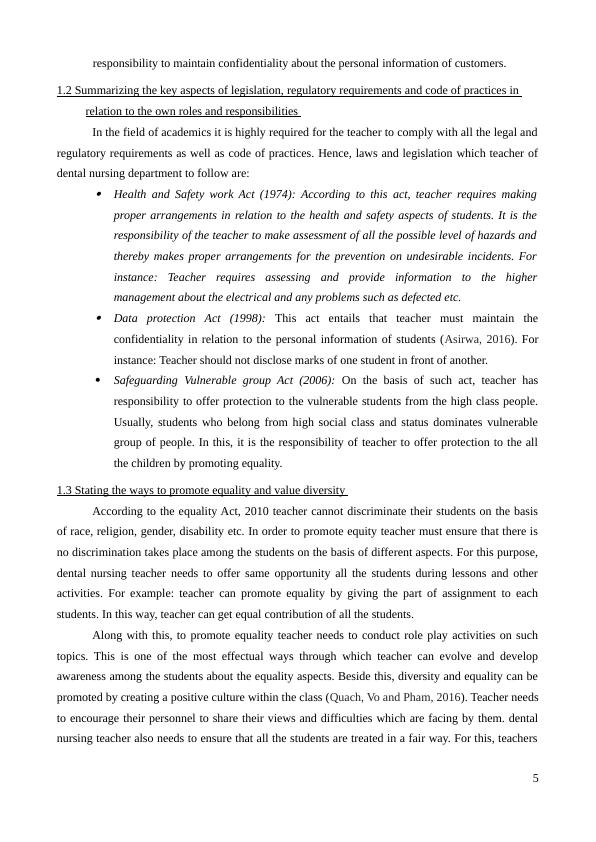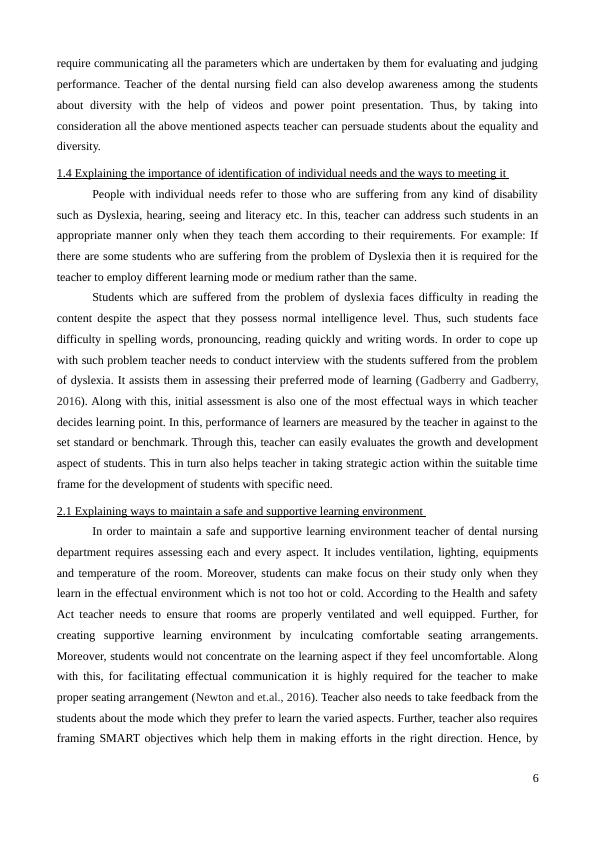Understanding Roles, Responsibilities & Relationships in Education and Training
Added on 2020-01-06
23 Pages9608 Words557 Views
Education and Training 1

Table of ContentsINTRODUCTION................................................................................................................................4Group A: Understanding roles, responsibilities and relationships in education and training ..............41.1 Explaining the roles and responsibilities of teacher in education and training ........................41.2 Summarizing the key aspects of legislation, regulatory requirements and code of practices in relation to the own roles and responsibilities ..................................................................................51.3 Stating the ways to promote equality and value diversity ........................................................51.4 Explaining the importance of identification of individual needs and the ways to meeting it ...62.1 Explaining ways to maintain a safe and supportive learning environment ..............................62.2 Stating the importance of appropriate behaviour and respect for others ..................................73.1 Presenting the ways in which teaching role facilitates working with other professionals .......73.2 Defining the boundaries take place between the role of teachers and other professionals........83.3 Stating the points of referral to meet the need of learners ........................................................8Group B: Understanding and using inclusive teaching approaches in education and training ...........81.1 Describing the features of inclusive teaching and learning ......................................................81.2 Comparing the strengths and weaknesses of teaching and learning approaches stated above .91.3 Explaining the importance of providing opportunities to the learner in relation to the development of varied skills and abilities .....................................................................................102.1 Stating the importance of creating an inclusive teaching and learning environment..............102.2 Presenting the aspects which places emphasis on the selection of teaching and learning approaches, resources and assessment ..........................................................................................102.3 Defining the ways to motivate and engage learners ...............................................................112.4 Summarizing the ways which helps in establishing the ground rules with learners ...............113.1 Devising an inclusive teaching and learning plan ..................................................................123.2 Justifying the teaching and learning approaches or method selected .....................................134.1 Using teaching and learning approaches, resources and assessment methods for meeting the learning need of individual ...........................................................................................................134.2 Ways for meeting the individual needs through the means of communication ......................144.3 Providing constructive feedback to learners in relation to meeting their individual needs ....145.1 Reviewing the effectiveness of own delivery inclusive teaching and learning ......................145.2 Identifying the areas which requires improvement in relation to the delivery of inclusive teaching and learning.....................................................................................................................15C. Understanding assessment in education and training ...................................................................151.1 Explaining the purposes of types of assessment which are used in education and training....151.2 Describing the characteristics of the different methods of assessment used in education and training...........................................................................................................................................161.3 Comparing the strengths and weaknesses of different methods of assessment.......................161.4 Assessing the ways in which different assessment methods can be adapted for meeting the learning need of individual............................................................................................................162.1 Explaining the extent to which learner and other involvement is required in the assessment process ..........................................................................................................................................172.2 Assessing the role of peers and self-assessment during the assessment process ...................172.3 Identifying the sources of information which should be available to the people involved in the assessment process ..................................................................................................................183.1 Describing the key features of constructive feedback ............................................................183.2 Explaining the extent to which constructive feedbacks make contribution in the assessment process...........................................................................................................................................183.3 Stating the ways for giving constructive feedback to the learners..........................................194.1 Explaining the significance of keeping assessment records ...................................................192

4.2 Summarizing the points due to which it is necessary to keep maintain the record of assessment .....................................................................................................................................19CONCLUSION .................................................................................................................................19References..........................................................................................................................................213

INTRODUCTIONEducation may be defined as a process which facilitates learning and assists in acquiring theknowledge, skills, values, beliefs and habits. There are several educational methods which can beundertaken by the individual for enhancing the knowledge level such as teaching, training,discussion and directed research. Training is the process which provides in-depth knowledge to theindividual about the specific field or area. It is highly significant at each level which offersopportunity to the individual to upgrade their skills, knowledge and competency in the desired field.The present report is based on the scenario which will discuss the roles performed by the teacher inthe dental nursing department. Further, it will also shed light on the legal practices related to theacademics. This report will also describe the aspects of equality, diversity as well as health andsafety department. GROUP A: UNDERSTANDING ROLES, RESPONSIBILITIES AND RELATIONSHIPS IN EDUCATION AND TRAINING 1.1 Explaining the roles and responsibilities of teacher in education and training There are several roles and responsibilities which teacher of dental nursing departmentsrequires following are enumerated below: RolesTeacher of dental nursing department has role to motivate the students while teaching forbetter learning. For this purpose, teacher needs to communicate positive thoughts which willdevelop high level of energy in the pupils. Further, teacher also plays a vital role in encouraging the individual for attending the classby making the environment of class highly positive (Carpenter and Dickinson, 2016).Moreover, when teacher only makes focus on lectures rather than other activities then itbecomes monotonous. In this, by conducting interesting activities teacher can developpositive feeling among the students. ResponsibilityDental nursing teacher has accountability to prepare suitable study framework for thestudents. Along with this, it also has responsibility to assess and undertake different easymodes of learning which facilitate better understanding among the students. Further, teacher also has responsibility to maintain appropriate behavior and disciplinewithin the classroom. Teachers of dental nursing departments are also assigned with the4

responsibility to maintain confidentiality about the personal information of customers. 1.2 Summarizing the key aspects of legislation, regulatory requirements and code of practices in relation to the own roles and responsibilities In the field of academics it is highly required for the teacher to comply with all the legal andregulatory requirements as well as code of practices. Hence, laws and legislation which teacher ofdental nursing department to follow are:Health and Safety work Act (1974): According to this act, teacher requires makingproper arrangements in relation to the health and safety aspects of students. It is theresponsibility of the teacher to make assessment of all the possible level of hazards andthereby makes proper arrangements for the prevention on undesirable incidents. Forinstance: Teacher requires assessing and provide information to the highermanagement about the electrical and any problems such as defected etc.Data protection Act (1998): This act entails that teacher must maintain theconfidentiality in relation to the personal information of students (Asirwa, 2016). Forinstance: Teacher should not disclose marks of one student in front of another.Safeguarding Vulnerable group Act (2006): On the basis of such act, teacher hasresponsibility to offer protection to the vulnerable students from the high class people.Usually, students who belong from high social class and status dominates vulnerablegroup of people. In this, it is the responsibility of teacher to offer protection to the allthe children by promoting equality. 1.3 Stating the ways to promote equality and value diversity According to the equality Act, 2010 teacher cannot discriminate their students on the basisof race, religion, gender, disability etc. In order to promote equity teacher must ensure that there isno discrimination takes place among the students on the basis of different aspects. For this purpose,dental nursing teacher needs to offer same opportunity all the students during lessons and otheractivities. For example: teacher can promote equality by giving the part of assignment to eachstudents. In this way, teacher can get equal contribution of all the students. Along with this, to promote equality teacher needs to conduct role play activities on suchtopics. This is one of the most effectual ways through which teacher can evolve and developawareness among the students about the equality aspects. Beside this, diversity and equality can bepromoted by creating a positive culture within the class (Quach, Vo and Pham, 2016). Teacher needsto encourage their personnel to share their views and difficulties which are facing by them. dentalnursing teacher also needs to ensure that all the students are treated in a fair way. For this, teachers5

require communicating all the parameters which are undertaken by them for evaluating and judgingperformance. Teacher of the dental nursing field can also develop awareness among the studentsabout diversity with the help of videos and power point presentation. Thus, by taking intoconsideration all the above mentioned aspects teacher can persuade students about the equality anddiversity. 1.4 Explaining the importance of identification of individual needs and the ways to meeting it People with individual needs refer to those who are suffering from any kind of disabilitysuch as Dyslexia, hearing, seeing and literacy etc. In this, teacher can address such students in anappropriate manner only when they teach them according to their requirements. For example: Ifthere are some students who are suffering from the problem of Dyslexia then it is required for theteacher to employ different learning mode or medium rather than the same. Students which are suffered from the problem of dyslexia faces difficulty in reading thecontent despite the aspect that they possess normal intelligence level. Thus, such students facedifficulty in spelling words, pronouncing, reading quickly and writing words. In order to cope upwith such problem teacher needs to conduct interview with the students suffered from the problemof dyslexia. It assists them in assessing their preferred mode of learning (Gadberry and Gadberry,2016). Along with this, initial assessment is also one of the most effectual ways in which teacherdecides learning point. In this, performance of learners are measured by the teacher in against to theset standard or benchmark. Through this, teacher can easily evaluates the growth and developmentaspect of students. This in turn also helps teacher in taking strategic action within the suitable timeframe for the development of students with specific need. 2.1 Explaining ways to maintain a safe and supportive learning environment In order to maintain a safe and supportive learning environment teacher of dental nursingdepartment requires assessing each and every aspect. It includes ventilation, lighting, equipmentsand temperature of the room. Moreover, students can make focus on their study only when theylearn in the effectual environment which is not too hot or cold. According to the Health and safetyAct teacher needs to ensure that rooms are properly ventilated and well equipped. Further, forcreating supportive learning environment by inculcating comfortable seating arrangements.Moreover, students would not concentrate on the learning aspect if they feel uncomfortable. Alongwith this, for facilitating effectual communication it is highly required for the teacher to makeproper seating arrangement (Newton and et.al., 2016). Teacher also needs to take feedback from thestudents about the mode which they prefer to learn the varied aspects. Further, teacher also requiresframing SMART objectives which help them in making efforts in the right direction. Hence, by6

End of preview
Want to access all the pages? Upload your documents or become a member.
Related Documents
Teaching Learning and Assessment in Education and Training UNIT 426lg...
|18
|5902
|420
Teaching Learning and Assessment in Education and Traininglg...
|18
|5542
|288
Teaching, Learning and Assessment in Education and Traininglg...
|32
|9916
|35
Teaching Learning and Assessment in Education and Training (Pass Criteria)lg...
|28
|9236
|449
Teaching, Learning and Assessment in Education and Traininglg...
|20
|7235
|411
Planning, Delivering and Assessing Learners in Own Specialist Arealg...
|17
|5356
|169
